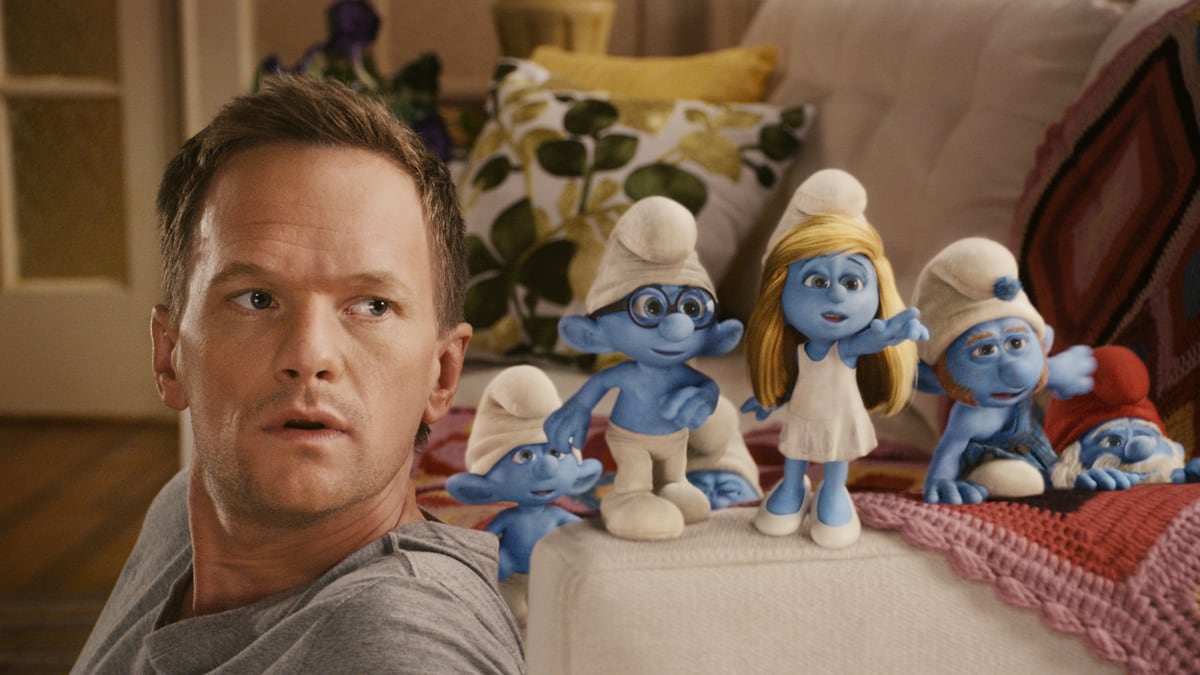Who could possibly resist the Smurfs? For a long time, in Hollywood, the answer to that question seemed pretty clear: everybody.
When The Smurfs movie opens in theaters on Friday, it marks the end of almost a decade of production woes and setbacks that made fans of one of the most popular brands in kid’s entertainment feel, well, very blue. The heroic little cartoons were stuck in development purgatory and shopped around to different studios—and they only landed in the movies with the help of a singing chipmunk named Alvin. This is the story of how things went wrong.
In an alternate universe, the Smurfs could have been romancing Snow White. In 1958, the plucky men were originally conceived as dwarves, according to Veronique Culliford, daughter of the Belgian illustrator Peyo, who created the Smurfs as sidekicks for a comic strip. His wife suggested blue as the color of their skin, so they wouldn’t blend in with the brown dirt or green trees. But the Smurfs soon become a pop culture phenomenon in France and Belgium, eventually securing their own series of books.
ADVERTISEMENT
The appeal of the Smurfs lies in their own adorableness. They live in the quaint Smurf Village, in homes made of mushrooms. All the members are named after the one attribute that makes them unique: Papa Smurf is the wise leader; Vanity carries a mirror around; Brainy is the intellect. The evil sorcerer Gargamel—and his cat Azrael—always hover nearby, in the hopes of kidnapping them.
But the series also has a strong sense of family ties. “I was born three weeks after the Smurfs were,” says Culliford one recent day over a cappuccino in a Manhattan restaurant, her own blue eyes twinkling. “I know he took some pictures of my blonde hair when I was very young. He made some drawings of me to create Smurfette.” The bombshell female Smurf character—who’s also partly inspired by Marilyn Monroe—was introduced in 1964.
Surprisingly, it took them a little longer than that to gain recognition on TV. As producer Jordan Kerner recalls it, his interest in the Smurfs dates all the way back to 1980. He was having breakfast with a good pal—NBC’s president at the time, the late Brandon Tartikoff—who asked him to skim Peyo’s comics. Tartikoff wanted to know if the Smurfs would work better in primetime or as a Saturday morning cartoon series. Kerner suggested the second option. Animated by Hanna-Barbera, the Smurfs became one of the most successful Saturday morning cartoons ever, spanning nine years and 272 episodes.

The quirky blue group became so integrated into our culture that even Johnny Carson would slip a Smurfs joke into his routine. A huge merchandising empire ballooned out of the series, selling 500 million Smurf figurines worldwide, not to mention the Smurfs cereal, crackers, and blue bottled water recently served at the film’s premiere.
By the late ‘90s, Kerner found himself producing two other live-action films based on hit vintage cartoons: George of the Jungle and Inspector Gadget. “I was looking for another franchise like that,” he says. “The Smurfs had only been off TV in the United States for seven years. Usually, you try to wait 15 years. But I knew it might take some time, so I went after them in 1997.” From 1997 to 2002, he sent a letter every year to Culliford in Brussels, asking to option a Smurf movie. He would say, “Please please please, I want to make it,” he recalls. “They kept saying ‘No! No! No!”
When he finally broke through, it was due to an unlikely source: E.B. White. Verner impressed the Smurfs gatekeepers when he mailed them a script of one of his projects, the live-action adaptation of Charlotte’s Web with Julia Roberts as the voice of the spider. “This is the kind of thing we do,” he remembers pitching them. “It doesn’t have to be silly. It can be emotional and strong. We made a deal.” Paramount wanted to develop the project under its Nickelodeon banner, which had just released the Rugrats movie. The Smurfs would be animated in the same way and hit theaters before their 50th anniversary in 2008.
There was just one sticking point: merchandising rights. “It took three years to negotiate that,” Kerner says. “The agreement is 100 pages.” Or, as Culliford puts it, “We know when you discuss with giant Hollywood people, it’s very difficult to keep all your rights. We had a nice negotiation. Everybody was happy in 2005.”
By that point, Paramount had undergone a complete management transformation, so all the people who were originally interested in the Smurfs were no longer there. Sherry Lansing had stepped down as CEO in 2004. And after Viacom, the studio’s parent company, made a deal to acquire the animation behemoth DreamWorks in 2005, the little Smurfs began to stagnate. “As you know with any studio, what was old, was out,” Kerner says.
That all changed during one December weekend in 2007. Fox released Alvin and the Chipmunks and saw opening numbers that wowed Hollywood. “On Monday morning, after Chipmunks grossed $45 million, every studio chair called me and said we want to do the Smurfs,” Kerner says. “I called my agents and said Warner has called, Fox has called, MGM has called. Paramount never called. Go figure. They owned it.”
But the bid that finally won him over came from another call. Michael Lynton, the chair of Sony Pictures, made a passionate argument for the Smurfs. He had grown up with them in the Netherlands, and desperately wanted to bring them to the big screen. His studio soon took over the rights of the Smurfs from Paramount.
After five years years, the Smurfs’ journey to the multiplex wasn’t complete yet. A cast was assembled, including Neil Patrick Harris as the New Yorker who discovers the Smurfs in his apartment, but the Smurfs themselves had to be developed through CGI technology. What would they look like? “There had to be no question they were Smurfs,” says the director Raja Gosnell (Scooby-Doo). “They couldn’t look like an elf or a troll. Finding the different variations within the Smurf DNA took some time.” The movie was delayed by another year.
“They didn’t greenlight us until a week before we started shooting,” Gosnell remembers. “Movies like this are hard to cost out, because there are so many unknowns. Any given Smurf shot can cost from $10,000 to $80,000. Part of my job was I had to commit to the studio that I can do this movie with 800 Smurf shots. I had to go through the script and defend that. It was a three-day meeting, with the greenlight hanging in balance. I’m not kidding. When these things go bad, they go way bad. The studio is pregnant, and suddenly they are in $30 million deeper than they thought they would be.” But at last, the Smurf movie got off the ground. “We started in March 2010,” he says.
With a new studio, the Smurfs also had a new story line. They were less “Shrek” and more “ET,” venturing out into the real world, and getting lost in New York. It’s fitting for the Big Apple to be the Smurfs’ new home. They’re certainly accustomed to leading global lives. “The brand is very well-known all over the world, because it is broadcasted on more than 120 channels for 30 years,” says William Auriol, the CEO of IMPS, the Belgian company that owns the rights to the Smurfs. “You can imagine there are more than billions of people who know the Smurfs. The level of notoriety is very high.” He claims, as far as nostalgia for classic kid’s properties go, “Mickey Mouse is first. We are second.” (Just don’t tell that to the Care Bears, Strawberry Shortcake or the Cabbage Patch Kids.)
One of the reasons why the Smurfs are such a draw might have something to do with the color of their skin. “They are not black. They are not white. They are not Asian. They are blue. This is a big chance for us to be welcomed with open arms all over the world. Most people think the Smurfs are really part of their own culture,” says Auriol. They are so integrated into each culture, they have a different name in each country. In Mexico, for example, the Smurfs are called “Los Pitufos,” in France they are “Les Schtroumpfs,” and in China they are “Nam Ching Ling.” That’s one reason why the Smurfs have pushed $8 billion in retail over the last 15 years, according to Auriol, who anticipates the numbers will only spike after the movie is released.
And finally, after living on the small screen for decades, the Smurfs are now movie stars. New York is celebrating the milestone with Smurf Week, with the Empire State building bathed in blue and the characters invading Yankee stadium. At least one of the biggest Smurfs fan is pleased with the new film. “I’m so happy!” says Culliford. “I think the spirit of my father is everywhere in the movie.”
If the Smurfs are a hit, Sony has optioned a trilogy of films. Kerner says he already knows the focus of the sequel. “Smurfette will be a big part of it,” he says. “We’re going to do our version of The Empire Strikes Back. Who is her father? Who is her family? If audiences like the movie, we’ll be starting in September for summer 2013.” And this time, he hopes, nothing will hold the Smurfs back.






